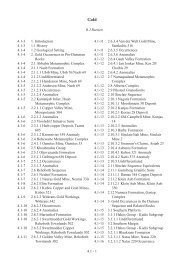Solar PV water pumping study - FINAL REPORT ... - UNDP, Namibia
Solar PV water pumping study - FINAL REPORT ... - UNDP, Namibia
Solar PV water pumping study - FINAL REPORT ... - UNDP, Namibia
You also want an ePaper? Increase the reach of your titles
YUMPU automatically turns print PDFs into web optimized ePapers that Google loves.
Feasibility Assessment for the Replacement of Diesel Pumps with <strong>Solar</strong> Pumps<br />
<strong>FINAL</strong> <strong>REPORT</strong>: September 2006<br />
The <strong>PV</strong>Ps used for analysis in this <strong>study</strong> are listed in Table 2.1 with their particular<br />
performance information.<br />
Table 2.1: <strong>PV</strong>P performance overview<br />
Grundfos SQ<br />
Flex 2)<br />
Lorenz PS<br />
Total Energie<br />
TSP 1000<br />
Total Energie<br />
TSP 2000+<br />
Pump type<br />
used<br />
Centrifugal &<br />
helical rotor<br />
Centrifugal &<br />
helical rotor<br />
Maximum<br />
array size<br />
[Wpeak]<br />
Maximum<br />
head<br />
[m]<br />
Hydraulic<br />
load 1)<br />
[m 4 /day]<br />
Maintenance<br />
interval<br />
[years]<br />
1,400 200 1,100 5<br />
1,200 230 1,000 3<br />
Helical rotor 1,280 130 900 5<br />
Centrifugal 5,600 120 ~ 4,000 5<br />
Watermax Diapraghm 300 100 3) 300 1<br />
1) The hydraulic load is calculated by multiplying the daily delivery [m 3 /day] by the head [m] at a fixed array<br />
size. This is fairly constant value and a measure of the <strong>PV</strong>Ps performance and operating range. Here the<br />
hydraulic load is calculated at an irradiance level of 6kWh/m2/day at the maximum array power of the <strong>PV</strong>P<br />
system.<br />
2) The Grundfos performance is based on the 900W motor. A new motor has been released but the manual<br />
sizing information has not been updated by Grundfos yet. The only pump unit added to the Grundfos<br />
range is the unit able to pump over a 200m head.<br />
3) The Watermax is supplied in four models: WA: Up to 80m, WB up to 100m, WC up to 150m and WD up to<br />
40m. Only the models up to 100m are considered for this <strong>study</strong>.<br />
The hydraulic load curves of the above pumps are shown in Figure 2.1. The figures are<br />
based in the technical specifications of the <strong>PV</strong>Ps.<br />
Daily Flow [m 3 /day]<br />
120<br />
100<br />
80<br />
60<br />
40<br />
20<br />
0<br />
0 30 60 90 120 150 180 210<br />
Head [m]<br />
Grundfos 1000<br />
Lorentz 1200<br />
Lorentz 840<br />
Total TSP 5600<br />
Watermax 300<br />
Figure 2.1: Hydraulic load curve of four <strong>PV</strong>P systems at maximum Watt peak<br />
The operating range of each pump is the area below each of the data series. The Grundfos<br />
and the Lorentz pump cover a similar area. These <strong>PV</strong>Ps are suitable for <strong>water</strong> needs at<br />
villages, for homesteads and lodges, and for livestock and game <strong>water</strong>ing. The low<br />
maintenance requirements make these pumps attractive for remote <strong>water</strong> supply solutions.<br />
<strong>PV</strong>Ps are not a cost effective solution for highly seasonal irrigation needs. A <strong>PV</strong>P achieves<br />
cost effectiveness through full use of the <strong>PV</strong>P modules. For example, using a <strong>PV</strong>P for half a<br />
Page 6 of 76




